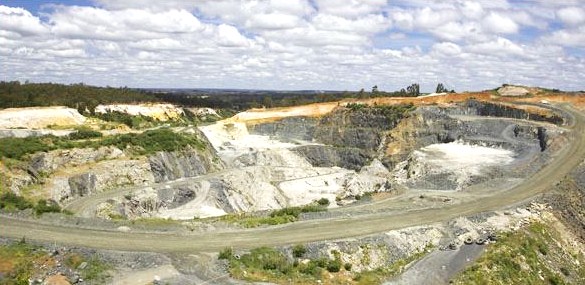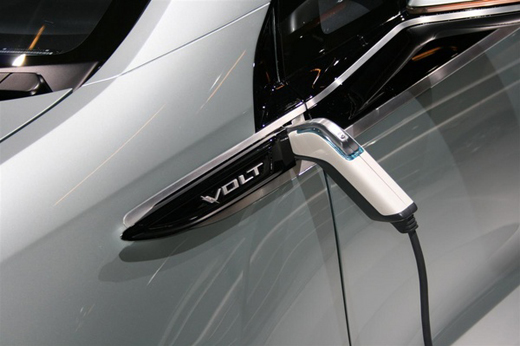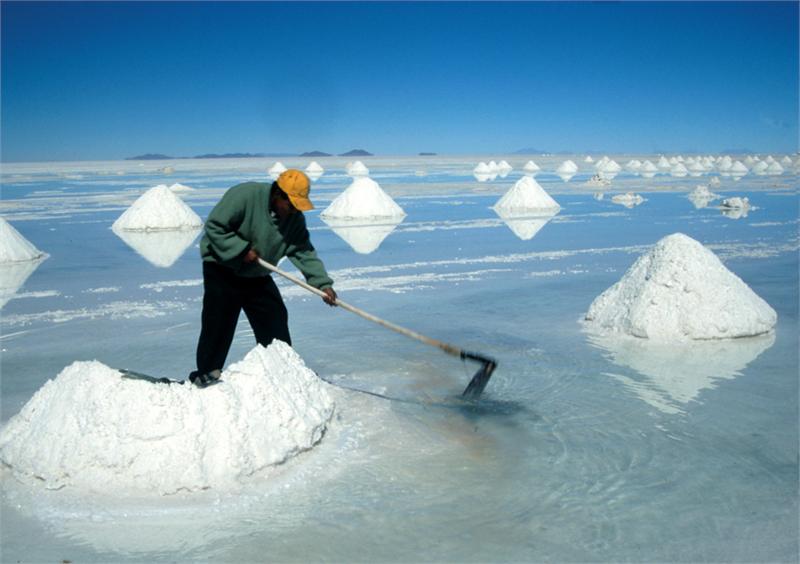3. Talison Lithium (TSX:TLH)
With a market capitalization near half a billion dollars, Talison Lithium (Stock Profile – TSX:TLH & OTC:TLTHF) is the biggest lithium mining company listed in Canada, and the largest pure lithium play in the world.
But in a move that speaks to how far the TSX Exchange has matured on the world mining stage, Talison is actually an Australian company with no connection to Canada other than its takeover of Salares Lithium, a TSXV listed junior with properties in Chile. The merger, which was completed last summer, gave Talison exposure to Salares’ lithium brine projects located in Chile, and creates as close to a diversified portfolio as exists in the suddenly burgeoning world of lithium mining. Salares resource in Chile has not be verified through NI-43-101, but the company says there is 394 square km of exploration potential within a number of salares brine lakes.
Meanwhile, at Greenbushes, a mine near Perth in Western Australia Talison mines tantalum concentrates and lithium minerals. The company purchased Greenbushes in 2007, and is already distributing to a well-established global customer base, including China. Production from the Greenbush mine fills 75% of the Chinese demand and a full third of total worldwide demand for lithium.

According to Ahead of the Heard’s Rick Mills, Talisun Lithium offers “potential investors many attributes” including “exposure to both mineral and brine sources of lithium… a well established and diversified global customer network… and a low-cost, rapid plant expansion (that is) currently in progress.”
In 2010 Talison sold all the lithium concentrate it produced and did so with high margins receiving an average price of over $300 per tonne (or $2,000 lithium carbonate equivalent). It must be noted that the $2,000 LCE price does not account for any associated end-user lithium carbonate conversion costs estimated to be in the range of $2,000 to $3,000 per tonne.
Talison, straight out of the gate looks like an early leader in the lithium race. The company reports that in a few years expanded operations should reach annual production of approximately 110,000 tonnes of lithium carbonate equivalent. The company is drilling at Greenbush and expects to provide an update on mineral reserves and resources by June, 2011. Talison also plans continued exploration work on their Chilean salars brine properties this year.
Mineral Resources from the company’s NI-43-101 report define a technical grade ore type at a 4% Li2O block cut-off and chemical grade ore type at a 3.2% Li2O block cut-off. Over the 12 year mine life the company expects to produce 4.6 million tonnes of lithium concentrate, or an estimated 700,000 tonnes of lithium carbonate equivalent.
4. Rodinia Lithium (TSXV:RM)
A tale of two projects. Toronto’s Rodinia Lithium (Stock Profile – TSXV:RM), like Talison and Lithium One, is developing lithium projects in two radically diverse geographical areas; Nevada and Argentina. But unlike its counterparts, Rodinia is focused exclusively on lithium brine production. A comparison of Rodinia’s properties reminds investors that geopolitical concerns are never far from the mining world.
Earlier this month, Rodinia announced results from an independent brine resource estimate of its Diablillios Project in the province of Salta in Argentina. As conducted by AMEC Internacional Ingenieria y Construccion, the report is consistent with the standards set out in Canadian Securities Administrators’ National Instrument 43-101 but does not constitute a NI-43-101 report. Nonetheless, the report identifies 4,959,000 tonnes of lithium carbonate equivalent, 19,837,000 tonnes of potassium chloride and 6,194,000 tonnes of B203.
Talking about the results William Randall, Rodinia’s President and CEO said, “This resource represents one of the largest estimated brine resources in the world. In addition to its size, the brine geochemistry is favourable with low magnesium-to-lithium and sulphate-to-lithium ratios.”
Lithium brine refers to lithium that is not mined, but rather, produced from brine, or salt water. To recover lithium this way salt rich brines are pumped from just beneath the surface of the desert and diverted into a series of large, shallow ponds. Areas of Nevada, Chile and Argentina are particularly rich in lithium brine.
At first blush the timing of Rodinia’s resource estimate was not ideal. A few days after the report
the government of neighbouring Jujuy province in Argentina announced a decree making lithium of strategic importance to their region making investors nervous that legislation around lithium in places like Argentina might become more widespread and protectionist. Then on March 11th the Japanese earthquake and subsequent tsunami hit resulting in general and widespread market instability. Shares of Rodinia feel from $0.57 to $.385 in a matter of days.

Rodinia was quick to point out that its two main projects were unaffected by the decree. President and CEO William Randall calmed fears by pointing out, “Mining legislation and government activity within the mining sector varies dramatically from province to province in Argentina, and the evolution of legislation in one province does not directly impact neighbouring provinces.”
Clearly, the position of the Jujuy province in Argentina has no bearing on the company’s Clayton Valley Project in Nevada which the company believes can offer some strategic benefits down the road.
The MiningFeeds.com sat down with William Randall to find out more about Rodinia Lithium, its strategic partnership with China’s Ningbo Shanshan and the company’s future plans. CLICK HERE for the exclusive interview.
5. Lithium Americas (TSX:LAC)
The Lithium Triangle, the high altitude, semi-arid salt flats at the intersection of Bolivia, Argentina and Chile is where nearly three quarters of the world’s salt lake lithium deposits are found.
It’s also where Lithium Americas’ (Stock Profile – TSX:LAC) Cauchari‐Olaroz property is located. A more specific description of the location of their property – smack dab in the middle of Jujuy province in Argentina – will provide much of the reason why the company’s stock was under pressure for most of March. Shares of Lithium Americas fell from $2.19 on February 28th to a low of $1.33 on March 16th, before recovering ground in sessions that followed.
In early March, Walter Barrionuevo, the Governor of Jujuy Province in Argentina, issued Decreto 7592/11, which changed existing laws for all existing and pending lithium projects. From now on in Jujuy, a ‘special expert commission” will review all projects. Lithium Americas, however, believes the market overreacted to the possibility of troubles at Cauchari‐Olaroz, pointing out that exploration and development permit applications were approved in late 2009 and is fully permitted through final feasibility. The Company is currently working on the environmental baseline and has confirmed that new legislation should not effect the current development program at Cauchari‐Olaroz, but is expected to increase the requirements for the final exploitation permit that will be requested once the final feasibility study is completed and presented to the Government as it is mandatory under the Argentinean law”.
Hernán Zaballa, a partner at Buenos Aires law firm Brons & Salas believes that mining in Argentina, a country in which each province owns its natural resources, gets a bad rap. “I do not think having different approaches to mining is a killer for Argentina and it is probably unfair the country is ranked so low in surveys like the one of the Fraser Institute” he recently told The Engineering and Mining Journal. “If you look at Canada or the U.S., you have big differences between states. Nevada is not California; Alberta is not British Columbia.”
And things aren’t all gloomy for Lithium Americas. Current disruptions aside, the company’s brine based project in Argentina was able to attract Magna International and Mitsubishi Corporation as equity investors. Both have off-take arrangements with the Company.

As Lithium Americas President and CEO Dr. Waldo said in an interview with BNN, “Lithium carbonate is not like gold where that you put an ad and you sell it… it has to be sold to a market that needs it. In our case our partners are Magna and Mitsubishi and this is something that gives you the comfort that there is a buy out there on the other side of the deal.”
Lithium Americas is clearly a little further ahead than some of the other junior miners in the Lithium Triangle. In mid-2010 the company engaged ARA Worley Parsons to perform engineering services on the Cauchari project. And on March 7th, 2011, the company entered into an agreement with SGS Canada for the completion of bench studies required for the design and construction of a lithium carbonate pilot plant and hopes, despite the new decree, to produce its first lithium carbonate before the end of 2011.
In late 2010, Lithium Americas released the results from an independent NI-43-101-compliant resource estimate completed under the supervision of Groundwater Insight. The company’s President and CEO Dr. Waldo Perez stated, “With measured and indicated lithium carbonate and potash (KCl) resource equivalents of 5.3 million tonnes and 17.3 million tonnes respectively, we have validated the potential of our resource.”
For a list of publicly traded lithium companies with market caps over $10 million – CLICK HERE.



 Follow us on Twitter
Follow us on Twitter Become our facebook fan
Become our facebook fan










Comments are closed.